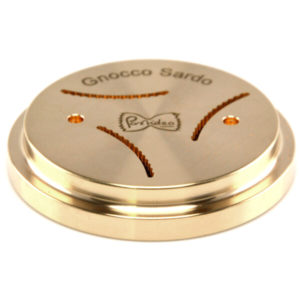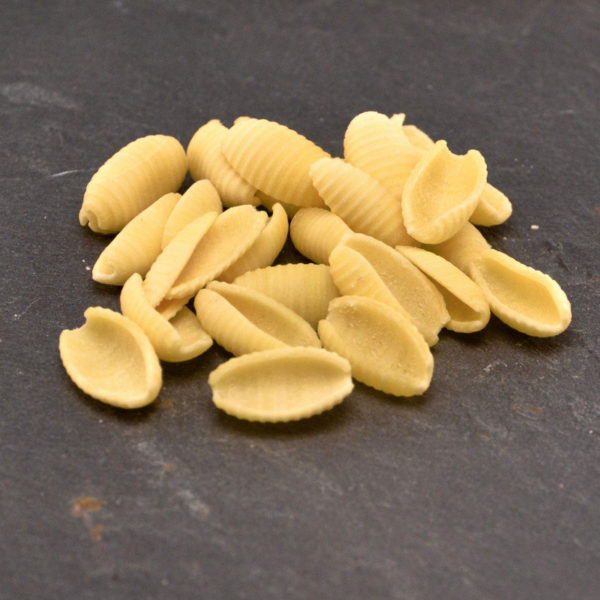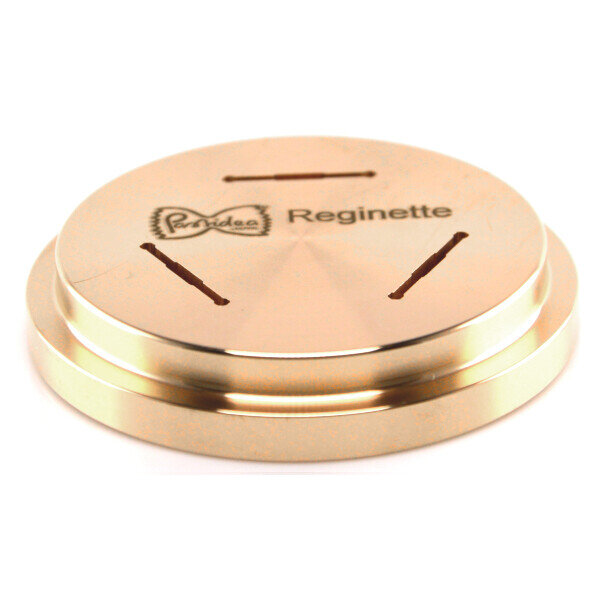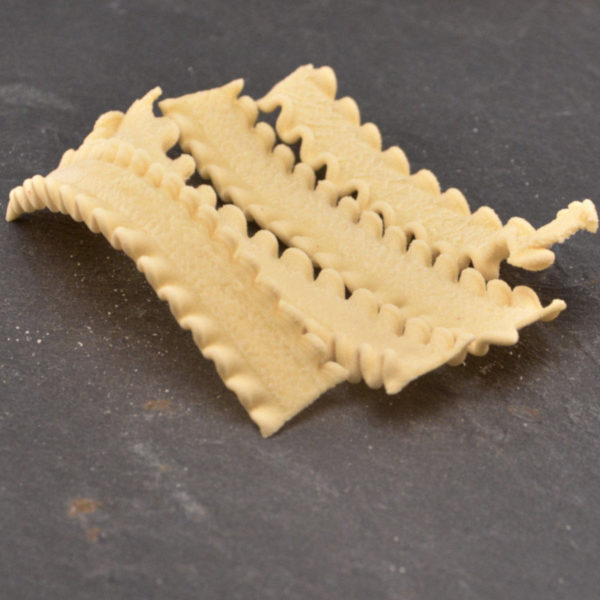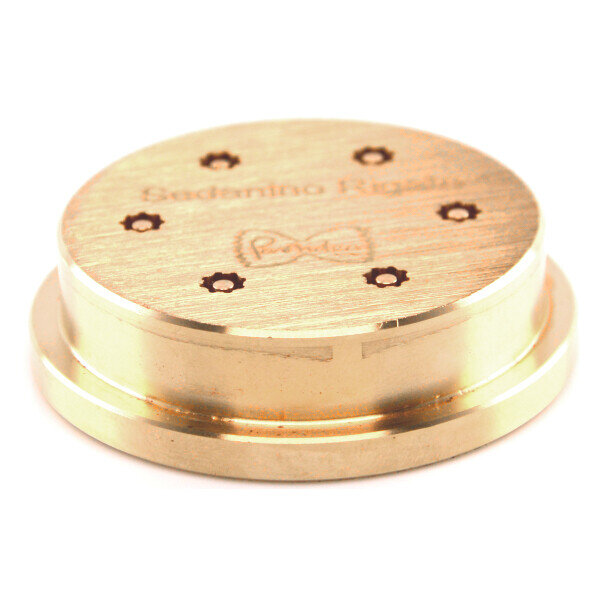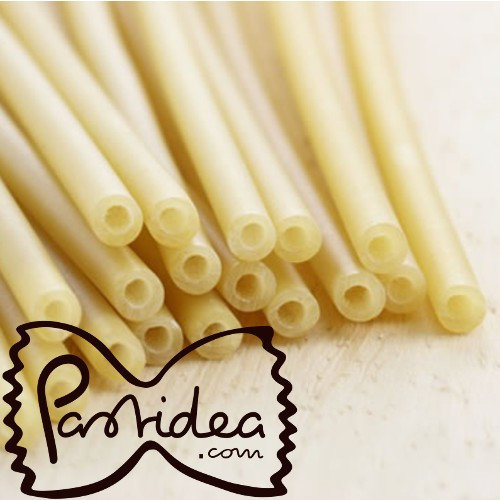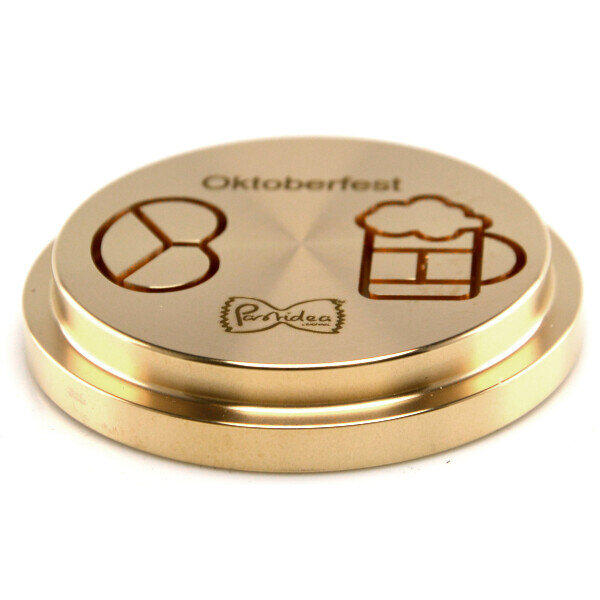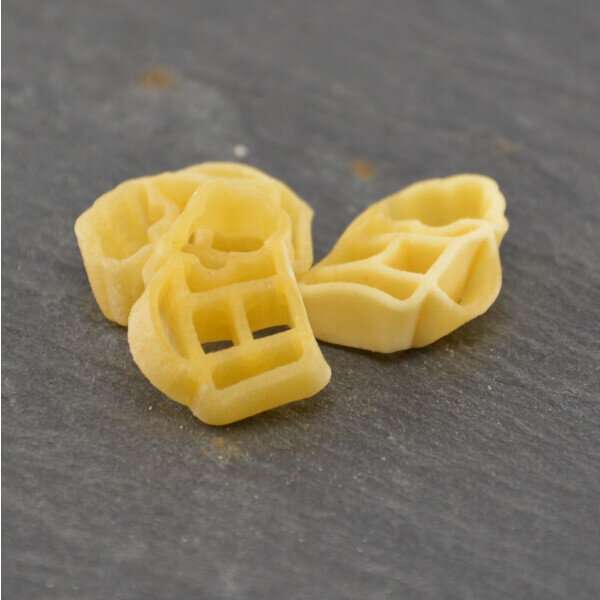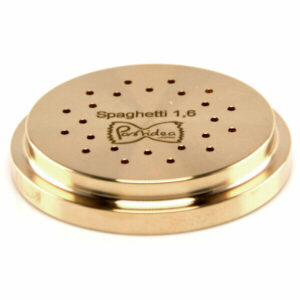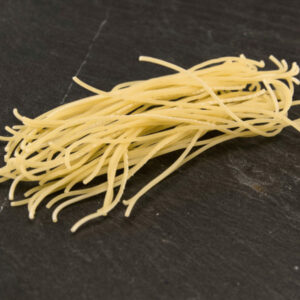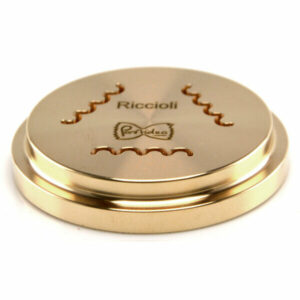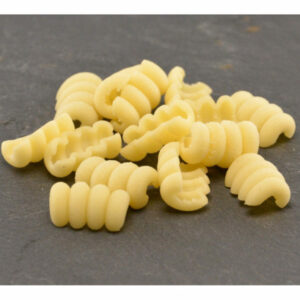57,90 € incl. VAT plus shipping costs
VAT included
excl. Shipping Rate
Bronze die Gnocco Sardo / Sardinian Gnocchi / Malloreddus Gnocco sardo are small, fluted mussels. The name already gives it away. It is a type of gnocchi that people like to eat in Sardinia. Attention: In Sardinia, these gnocchi are always prepared without eggs (i.e. only durum wheat and water). In other areas of Italy people are more tolerant. These noodles are also known under the name Malloreddus. Because the pasta is pulled through a bronze die, the result is a very slightly roughened surface. This means the sauce can be absorbed particularly well. Cavatelli are very similar to Gnocco Sardo. The difference lies in the fine stripes on the surface, while the cavatelli are smooth. Size: 19 mm Thickness: 1,2 mm Diameter die: 56 mm Pasta insert for the following professional pasta machines: La Fattorina Fimar MPF 1.5 Fimar PF15E Arcobaleno AEX-10 Bartscher GGM-Gastro NMF5 No adapter or similar is required. The die fits directly into the above-mentioned pasta machines. Why bronze: Bronze dies were the traditional way of making pasta. The pasta made “al bronzo” can only be found rarely and usually only in selected delicatessens. By pressing the pasta dough through the bronze matrices, the surface of the pasta is slightly roughened at the same time, making the pasta easier to grip. This allows the pasta to better absorb the sauce, flavors and spices later on. Would you like to learn more about bronze matrices? Then we recommend this article to you here. Recipe: It is recommended to use durum wheat semolina, enough cold liquid such as water and/or egg. The dough should be kneaded for about 8-10 minutes, this is the only way the gluten from the durum wheat can fully develop. The result should be a moist, crumbly dough. You can find a standard recipe for our matrices here. The matrices can also be used to produce gluten-free pasta. Storage: Do you have several bronze matrices and are looking for storage to protect the matrix from dust and darkening caused by light? Then we recommend our storage systems to you here .
40,90 € incl. VAT plus shipping costs
VAT included
excl. Shipping Rate
Bronze Reginette die “Reginette” means something like “little queen” in German. We think this noble name fits perfectly. Tip: Mafalde and Reginette are very similar pastas. They both have a wavy edge that catches the sauce particularly well. The difference is in the width. The reginette are 1,8 cm wide, the bronze mafalde 2,8 cm. Reginette are mainly eaten long. Mafalde, on the other hand, can often be found cut short. Diameter of die: 56 mm Pasta insert for the following professional pasta machines: La Fattorina Fimar MPF 1.5 Fimar PF15E Arcobaleno AEX-10 Bartscher GGM-Gastro NMF5 No adapter or similar is required. The die fits directly into the above-mentioned pasta machines. Why bronze: Bronze dies were the traditional way of making pasta. The pasta made “al bronzo” can only be found rarely and usually only in selected delicatessens. By pressing the pasta dough through the bronze matrices, the surface of the pasta is slightly roughened at the same time, making the pasta easier to grip. This allows the pasta to better absorb the sauce, flavors and spices later on. Would you like to learn more about bronze matrices? Then we recommend this article to you here. Recipe: It is recommended to use durum wheat semolina, enough cold liquid such as water and/or egg. The dough should be kneaded for about 8-10 minutes, this is the only way the gluten from the durum wheat can fully develop. The result should be a moist, crumbly dough. You can find a standard recipe for our matrices here. The matrices can also be used to produce gluten-free pasta. Storage: Do you have several bronze matrices and are looking for storage to protect the matrix from dust and darkening caused by light? Then we recommend our storage systems to you here .
40,90 € incl. VAT plus shipping costs
VAT included
excl. Shipping Rate
Bronze Bucatini die Bucatini is very large spaghetti, but with a hole in the middle (bucatini has the Italian word buco = hole). The Italians are very proud of their bucatini, you can find them all over Italy. Many say they come from Sicily, but I have also heard in the Rome area that they are typical of the region. Bucatini are very long pasta, if you let them out 30 cm long you are doing everything right. They are often served with rich sauces such as an Amatriciana or a Carbonara. But you can also find many vegetable sauces, for example with broccoli, on the menu in Italian restaurants. There is another special feature that you should know: In Germany people eat macaroni or macaroni with a smaller diameter than in Italy, 0,3 - 0,5 cm diameter is the average for macaroni in Germany (in Italy, however, approx. 1 cm ). This Italian bucatini is very close to the German macaroni that is so popular with children. You just have to cut them shorter. And you shouldn't talk about it too loudly, because Italians don't like the change in pasta terms. But here we are among ourselves, please don't tell anyone else 🙂 Diameter of die: 56 mm Pasta insert for the following professional pasta machines: La Fattorina Fimar MPF 1.5 Fimar PF15E Arcobaleno AEX-10 Bartscher GGM-Gastro NMF5 No adapter or similar is required . The die fits directly into the above-mentioned pasta machines. Why bronze: Bronze dies were the traditional way of making pasta. The pasta made “al bronzo” can only be found rarely and usually only in selected delicatessens. By pressing the pasta dough through the bronze matrices, the surface of the pasta is slightly roughened at the same time, making the pasta easier to grip. This allows the pasta to better absorb the sauce, flavors and spices later on. Would you like to learn more about bronze matrices? Then we recommend this article to you here. Recipe: It is recommended to use durum wheat semolina, enough cold liquid such as water and/or egg. The dough should be kneaded for about 8-10 minutes, this is the only way the gluten from the durum wheat can fully develop. The result should be a moist, crumbly dough. You can find a standard recipe for our matrices here. The matrices can also be used to produce gluten-free pasta. Storage: Do you have several bronze matrices and are looking for storage to protect the matrix from dust and darkening caused by light? Then we recommend our storage systems to you here .
40,90 € incl. VAT plus shipping costs
VAT included
excl. Shipping Rate
Bronze Oktoberfest die Motif matrix for friends of the Munich Oktoberfest and lovers of Swabian and Bavarian pretzels. Attention: When using motif matrices, please always use enough liquid (approx. 10 grams more per 500 grams of dry ingredients than the pasta maker would like) and a maximum of one level teaspoon of binder (per 500 grams). If the dosage of the liquid is too low, the pressure when it is pressed out will be too high and the die could be damaged. Size: 39 mm Thickness: 1,2 mm Diameter die: 56 mm Pasta insert for the following professional pasta machines: La Fattorina Fimar MPF 1.5 Fimar PF15E Arcobaleno AEX-10 Bartscher GGM-Gastro NMF5 No adapter or similar is required. The die fits directly into the above-mentioned pasta machines. Why bronze: Bronze dies were the traditional way of making pasta. The pasta made “al bronzo” can only be found rarely and usually only in selected delicatessens. By pressing the pasta dough through the bronze matrices, the surface of the pasta is slightly roughened at the same time, making the pasta easier to grip. This allows the pasta to better absorb the sauce, flavors and spices later on. Would you like to learn more about bronze matrices? Then we recommend this article to you here. Recipe: It is recommended to use durum wheat semolina, enough cold liquid such as water and/or egg. The dough should be kneaded for about 8-10 minutes, this is the only way the gluten from the durum wheat can fully develop. The result should be a moist, crumbly dough. You can find a standard recipe for our matrices here. The matrices can also be used to produce gluten-free pasta. Storage: Do you have several bronze matrices and are looking for storage to protect the matrix from dust and darkening caused by light? Then we recommend our storage systems to you here .
40,90 € incl. VAT plus shipping costs
VAT included
excl. Shipping Rate
Bronze die Spaghetti 1,6 Very thin spaghetti version. It's roughly comparable in size to Barilla No. 3 The name spaghetti means something like small strings. The name probably comes from the fact that spaghetti used to be made with a “guitar”. The guitar was a wooden box with metal strings stretched tightly over it, like a real musical guitar. The pasta dough was placed over these strings and pressed against the wires with a pasta roller so that the spaghetti fell down in strips. Thickness: 1.6 mm Diameter of die: 56 mm Pasta insert for the following professional pasta machines: La Fattorina Fimar MPF 1.5 Fimar PF15E Arcobaleno AEX-10 Bartscher GGM-Gastro NMF5 No adapter or similar is required. The die fits directly into the above-mentioned pasta machines. The die is delivered together with a transparent transport protection box. Why bronze: Bronze dies were the traditional way of making pasta. The pasta made “al bronzo” can only be found rarely and usually only in selected delicatessens. By pressing the pasta dough through the bronze matrices, the surface of the pasta is slightly roughened at the same time, making the pasta easier to grip. This allows the pasta to better absorb the sauce, flavors and spices later on. Would you like to learn more about bronze matrices? Then we recommend this article to you here. Recipe: It is recommended to use durum wheat semolina, enough cold liquid such as water and/or egg. The dough should be kneaded for about 8-10 minutes, this is the only way the gluten from the durum wheat can fully develop. The result should be a moist, crumbly dough. You can find a standard recipe for our matrices here. The matrices can also be used to produce gluten-free pasta. Storage: Do you have several bronze matrices and are looking for storage to protect the matrix from dust and darkening caused by light? Then we recommend our storage systems to you here .
43,90 € incl. VAT plus shipping costs
VAT included
excl. Shipping Rate
Bronze Riccioli die / ringlets Everything is just right with this pasta shape. Riccioli means something like “curls”. That is, the noodles curl up like curls of hair. Ideal for sauce lovers, because the shape next to the noodles makes the sauce particularly good. This effect is further enhanced by the rough surface of the pasta, which can only be achieved with bronze matrices. Size: 39 mm Thickness: 1,2 mm Diameter die: 56 mm Pasta insert for the following professional pasta machines: La Fattorina Fimar MPF 1.5 Fimar PF15E Arcobaleno AEX-10 Bartscher GGM-Gastro NMF5 No adapter or similar is required. The die fits directly into the above-mentioned pasta machines. Why bronze: Bronze dies were the traditional way of making pasta. The pasta made “al bronzo” can only be found rarely and usually only in selected delicatessens. By pressing the pasta dough through the bronze matrices, the surface of the pasta is slightly roughened at the same time, making the pasta easier to grip. This allows the pasta to better absorb the sauce, flavors and spices later on. Would you like to learn more about bronze matrices? Then we recommend this article to you here. Recipe: It is recommended to use durum wheat semolina, enough cold liquid such as water and/or egg. The dough should be kneaded for about 8-10 minutes, this is the only way the gluten from the durum wheat can fully develop. The result should be a moist, crumbly dough. You can find a standard recipe for our matrices here. The matrices can also be used to produce gluten-free pasta. Storage: Do you have several bronze matrices and are looking for storage to protect the matrix from dust and darkening caused by light? Then we recommend our storage systems to you here .


